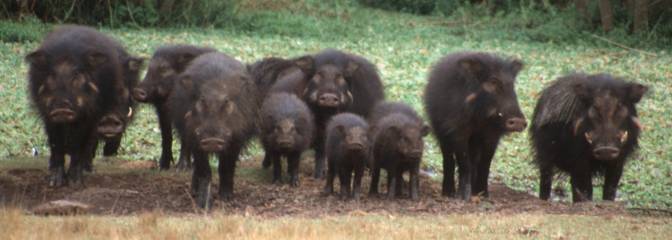- Giant forest hog
Taxobox
name = Giant forest hog

image_width = 325px
status = LC
status_system = iucn3.1
regnum =Animal ia
phylum = Chordata
classis =Mammal ia
ordo =Artiodactyla
familia =Suidae
genus = "Hylochoerus"
species = "H. meinertzhageni"
binomial = "Hylochoerus meinertzhageni"
binomial_authority = Thomas, 1904The Giant Forest Hog ("Hylochoerus meinertzhageni") is the largest wild member of the
pig familySuidae . It is the only member of the genus "Hylochoerus". Males can reach as much as 2 metres in length and 1.1 metres high at the shoulder and have been known to weigh as much as 600 pounds (273 kg); but such claims are often exaggeration and must be scrutinized. Unlike most species of wild suid, the giant forest hog has extensive hairs on its body, though these tend to become less pronounced as the animal ages. It is mostly black in colour on the surface, though hairs nearest the skin of the animal are a deep orange colour. Its ears are large and pointy, and itstusk s are much smaller than those of thewarthog but bigger than that of the thebushpig .Giant forest hogs occur in the
Jungles of West andCentral Africa , extending also into the mountain forests of theRwenzori Mountains and as far east asMount Kenya and theEthiopian Highlands . The giant forest hog is aherbivore .Giant forest hogs are nocturnal, being mainly active for about four to eight hours a day between dusk and dawn. They live in large herds (sounders) of up to twenty animals. However, breeding pairs leave a sounder completely and do not tolerate other individuals. This means that giant forest hogs cannot be domesticated, since this requirement for large breeding territories precludes their being kept in enclosures. They are, though, much more docile than other African suids.
Though known to native peoples of tropical African forests for many millennia and subject in many of these cultures to various
taboo s and superstitions, giant forest hogs were not scientifically classified until 1904.ources
* [http://animaldiversity.ummz.umich.edu/site/accounts/information/Hylochoerus_meinertzhageni.html Hylochoerus meinertzhageni]
References
*
Wikimedia Foundation. 2010.
